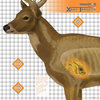If he's hit in the lung, you'll probably find him within a hundred to a hundred and fifty yards. Sometimes the blood trail doesn't start within the first thirty to forty yards or when it does, it plays out. Sometimes even with a correctly hit animal with a good bullet, you'll never find a blood trail.
You'll also read things like a wounded animal always goes downhill, toward water, takes the easiest path etc. Remember you're dealing with an animal in shock, and they just go. If they find thick brush, they're often not so easy to find. Expect sudden changes in direction for no apparent reason.
And for some reason I can't explain, often a lung hit animal will take a sudden hook backwards. If you do find a played out blood trail, look for this. Calling your shots is not always as easy as you might imagine. When you're looking, look around as much as you study the ground. If you see the animal ahead, and his head is up, don't assume he's finished, shoot again. Sometimes they'll run a little ways and hide. Once they're bumped, they're likely to run until they die.
In rough country, it may take an hour or more to locate an animal who died within fifty yards. For this reason, I don't like to hunt too near dark. Finding him the next morning after the meat has soured doesn't mean anything. I have no objection to a person being proud of the antlers, if they want to care about a thing like that, but the purpose of the hunt is food.


